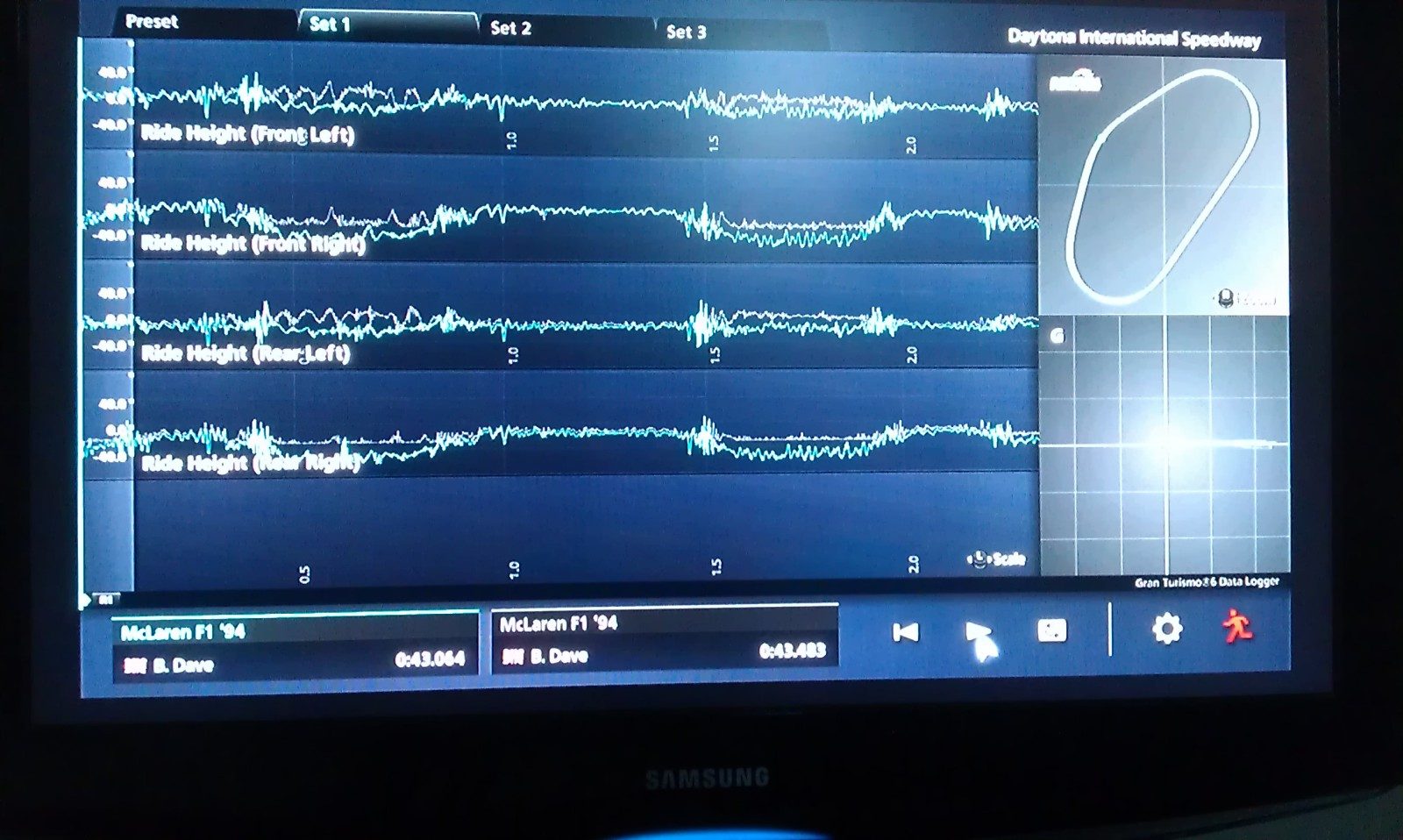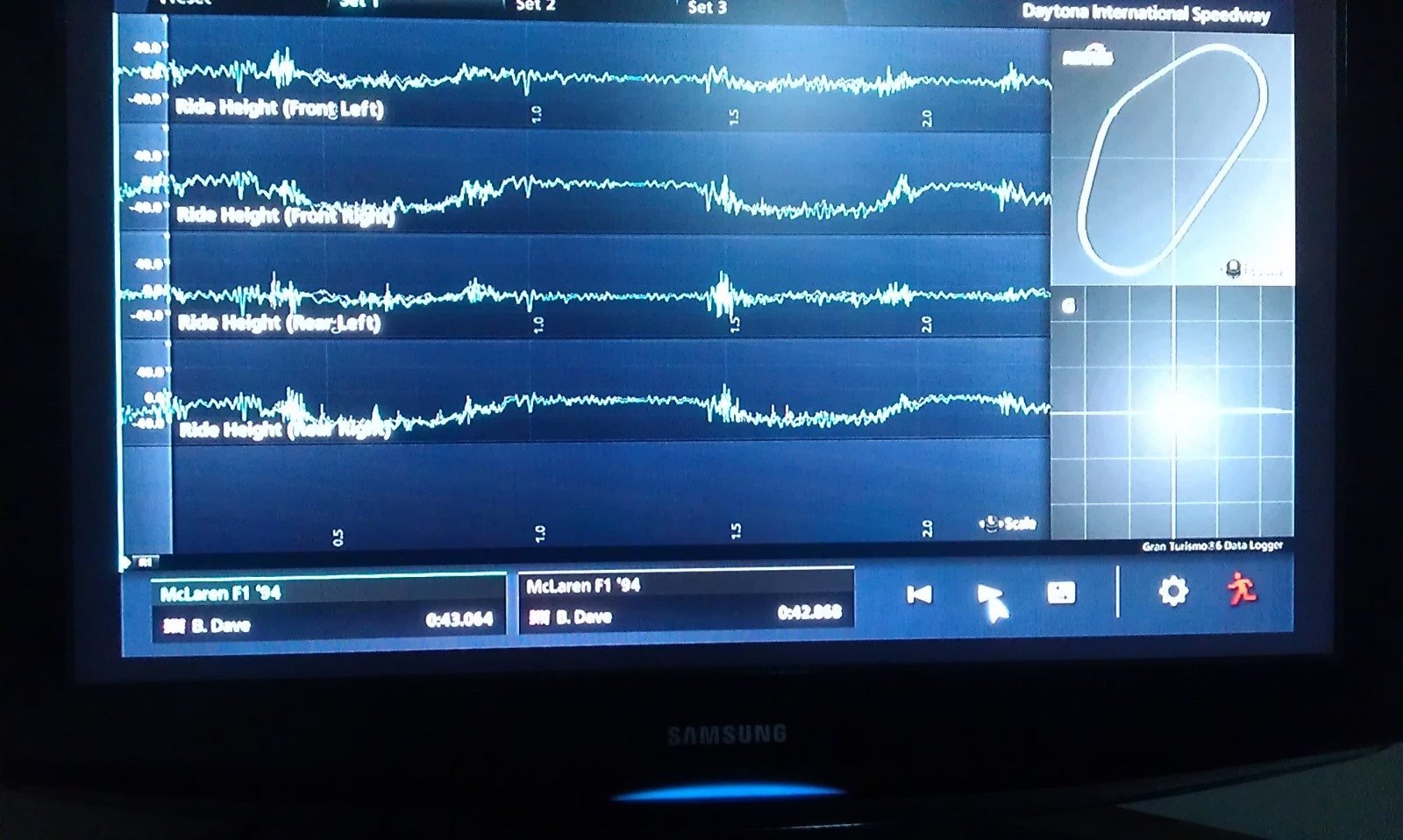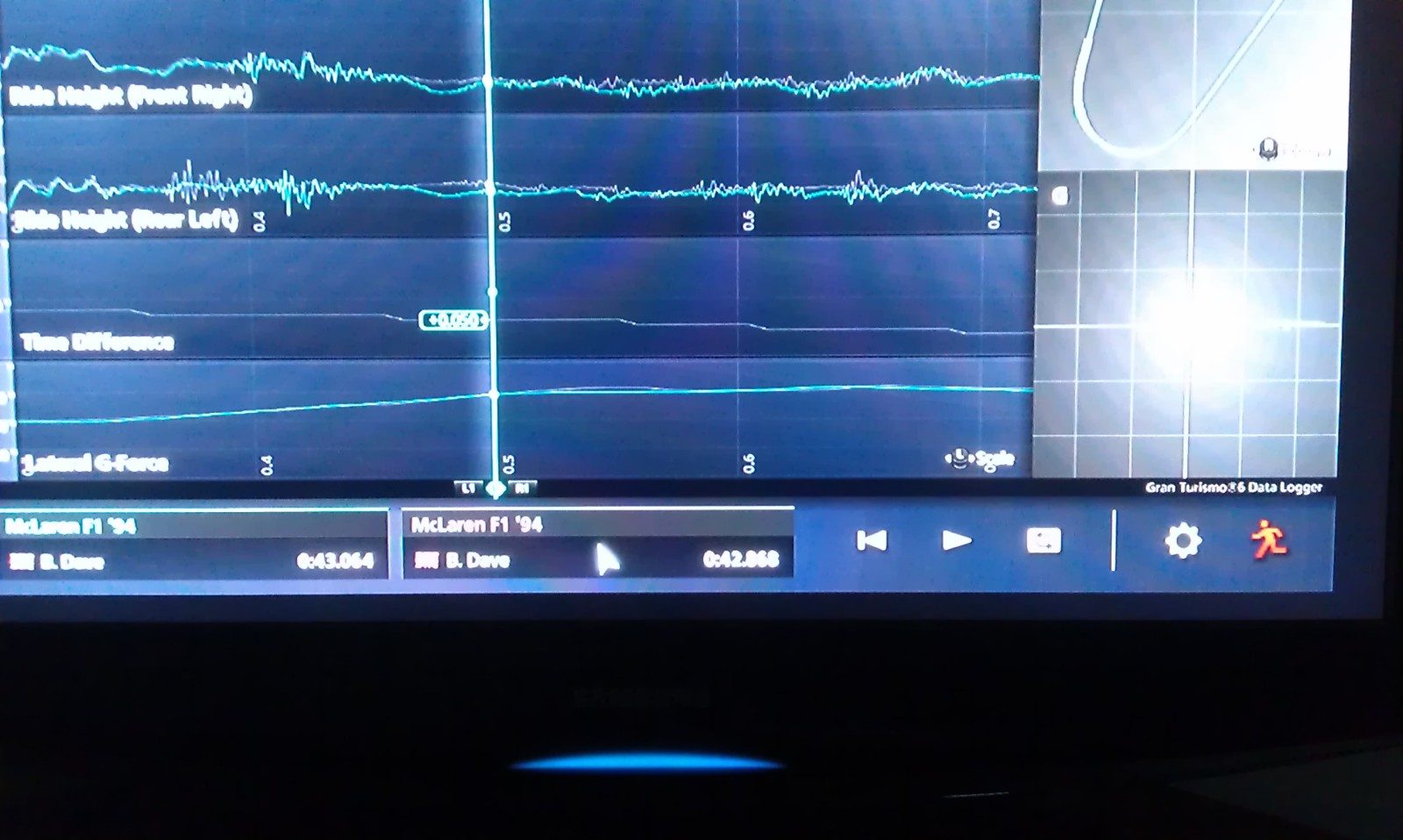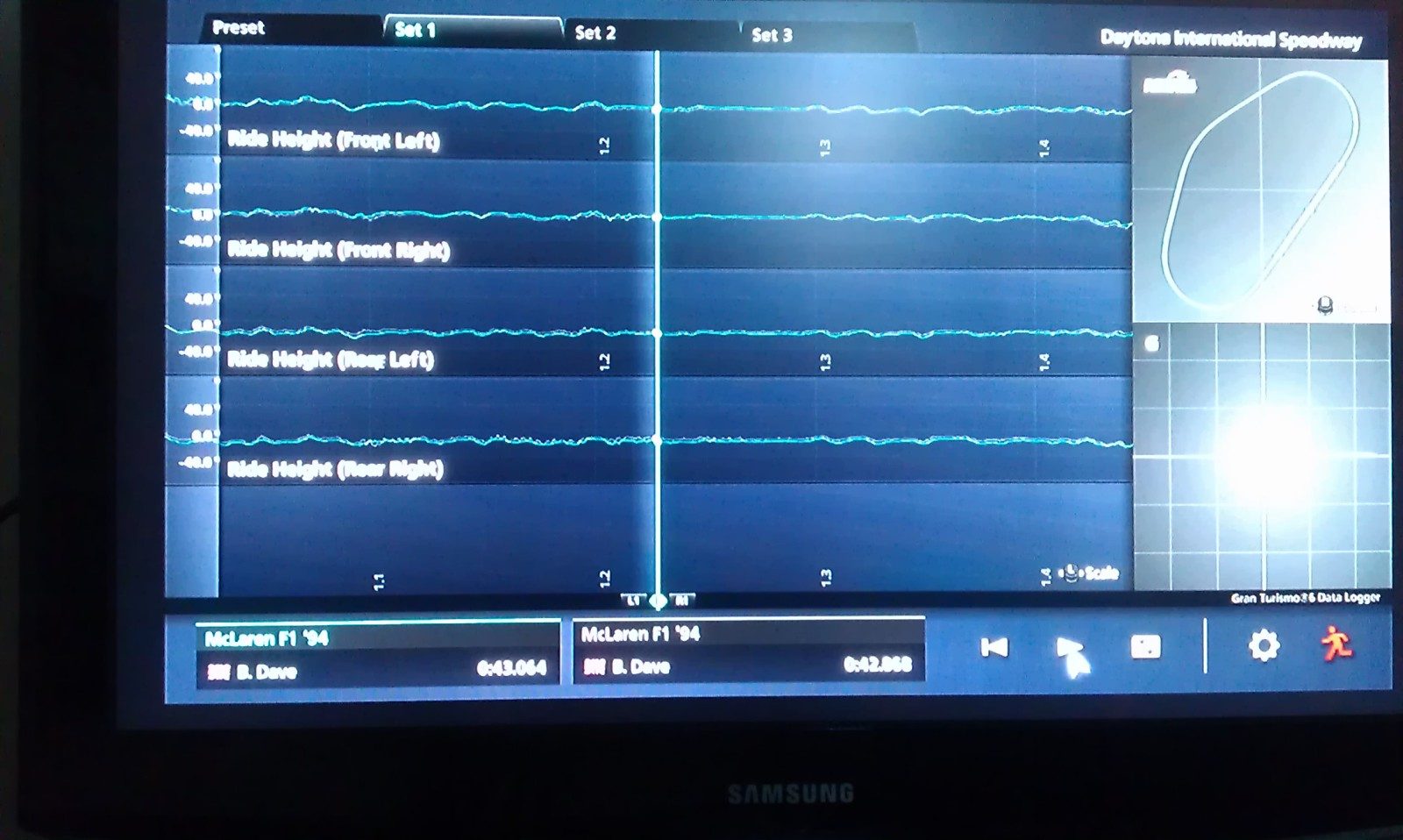- 285

- Oxfordshire
- Bread_45
Hi,
Now that we've got the data logger, what options does this open up for tuning? Perhaps people's theories will be able to be fleshed out with numbers, or if someone has a handling problem, maybe the logger will give some insight?
There is certainly more that could be implemented by PD, one of the first things that I noticed was that some readouts have little boxed numbers (e.g. speed), but the G readings and ride height don't. I hope that PD add these relatively small things in, as I've been forced to approach my TV with graph paper or a ruler if I want a figure. Obviously more numbers like tyre temps, dynamic camber etc would also be nice.
Below are a few early tests/observations I've made.
1) Vehicle speed vs wheel speed
On my S13 ~250BHP, CS tyres, I noticed a distinct difference between vehicle speed and rear wheel speed in a straight line under acceleration. Front wheel speed was pretty much always equal to the vehicle speed. for example, on the back straight at tsukuba, 5th gear, 100 MPH vehicle speed, the rear wheels were reading 107 mph (fronts were 100). Therefore it looks like the GT6 tyre model includes slip percentage (i.e. I had a slip percentage of 7%). This is a sensible number for the real world [1], though I was a bit suprised that my 250 BHP car could generate this much at 100 mph in top gear. The wheel speed in general seems to look realistic, if you pull the handbrake the rears drop to zero as you've locked the tyres, and the inside/outside wheels in a turn show a difference (since the outside ones take a longer path in the same time)
Thoughts:
a) The driven wheel speeds could be really useful for LSD tuning. With what I thought was a well set LSD (both rear tyres turn red at the same time), the inside wheel was often going a bit faster than the outside. Coming out of a turn, I think you'd want them either rotating at the same speed for straight line accel, or maybe with the outside tyre still rotating a bit faster (since you are just leaving the turn).
b) The wheel speeds vs vehicle speed could also be useful for seeing how ABS is implemented in the game (i.e. how much negative slip is allowed under braking), likewise for TCS and maybe even ASM.
[1] http://scholar.lib.vt.edu/theses/available/etd-5440202339731121/unrestricted/CHAP3_DOC.pdf
2) Ride height telemetry
This is one setting which I really wish they'd put a numerical indicator on! One brief test I have done is to look at the amount of body roll, i.e. RF vs LF, also RR vs LR ride heights, during cornering. I wanted to know how much one click on the ARBs limits body roll, vs how much spring is needed. Due to having to eyeball the graphs the RHs are probably only accurate to the nearest 5mm, likewise the G force was a nominal 1G, but could have been +/- 5%.
S13 on CS tyres in a 1G turn
RH 110/110 (FC sus default)
Dampers 1/1 (didn't want these complicating things - I measured on a flat portion of the RH graph so the dampers shouldn't be doing anything anyway, since the suspension isn't moving)
i) Springs stock (3.12/2.97)
ARB 1/1
FL -30 FR +60 difference 90
RL -40 RR +35 difference 75
Looks like there was some longitudinal accel here that I hadn't noticed (the rears are lower). There's a considerable difference between the front and rear roll, 25mm! I didn't think my measurements would be that inaccurate, could GT6 be modelling chassis flex?!?!
ii) Same as above except ARB 7/7
FL -20 FR +50 difference 70
RL - 25 RR +30 difference 55
again, front/rear roll is different.
iii) ARB 1/1, springs max/max (11.61/10.34)
FL -15 FR +20 difference 35
RL -15 RR +15 difference 30
only a slight difference here.
I'm in the process of analysing the data with some more values, then I can try to work out how much spring one ARB click is worth (it might or might not be linear, so I'm waiting to see what I get before commenting). It does look like the max ARB/default springs isn't as stiff as the max springs/default ARB though.
Thoughts:
The RH graphs would be excellent for testing the amount of downforce you get from aero, you could do a run on SSRX and see how much the car gets sucked on to the deck.
It would also be interesting to see how sharp the changes in RH are when going over bumps, using different damper stiffnesses. If the dampers are stiff and the wheel bumps up off the ground, I wonder whether the RH increases i.e. is it truly body-ground distance. Or is it strut length, which wouldn't change much.
I'm off to the Eiger or Cape Ring jumps to see if the RH goes to +2000!
Cheers,
Bread
Now that we've got the data logger, what options does this open up for tuning? Perhaps people's theories will be able to be fleshed out with numbers, or if someone has a handling problem, maybe the logger will give some insight?
There is certainly more that could be implemented by PD, one of the first things that I noticed was that some readouts have little boxed numbers (e.g. speed), but the G readings and ride height don't. I hope that PD add these relatively small things in, as I've been forced to approach my TV with graph paper or a ruler if I want a figure. Obviously more numbers like tyre temps, dynamic camber etc would also be nice.
Below are a few early tests/observations I've made.
1) Vehicle speed vs wheel speed
On my S13 ~250BHP, CS tyres, I noticed a distinct difference between vehicle speed and rear wheel speed in a straight line under acceleration. Front wheel speed was pretty much always equal to the vehicle speed. for example, on the back straight at tsukuba, 5th gear, 100 MPH vehicle speed, the rear wheels were reading 107 mph (fronts were 100). Therefore it looks like the GT6 tyre model includes slip percentage (i.e. I had a slip percentage of 7%). This is a sensible number for the real world [1], though I was a bit suprised that my 250 BHP car could generate this much at 100 mph in top gear. The wheel speed in general seems to look realistic, if you pull the handbrake the rears drop to zero as you've locked the tyres, and the inside/outside wheels in a turn show a difference (since the outside ones take a longer path in the same time)
Thoughts:
a) The driven wheel speeds could be really useful for LSD tuning. With what I thought was a well set LSD (both rear tyres turn red at the same time), the inside wheel was often going a bit faster than the outside. Coming out of a turn, I think you'd want them either rotating at the same speed for straight line accel, or maybe with the outside tyre still rotating a bit faster (since you are just leaving the turn).
b) The wheel speeds vs vehicle speed could also be useful for seeing how ABS is implemented in the game (i.e. how much negative slip is allowed under braking), likewise for TCS and maybe even ASM.
[1] http://scholar.lib.vt.edu/theses/available/etd-5440202339731121/unrestricted/CHAP3_DOC.pdf
2) Ride height telemetry
This is one setting which I really wish they'd put a numerical indicator on! One brief test I have done is to look at the amount of body roll, i.e. RF vs LF, also RR vs LR ride heights, during cornering. I wanted to know how much one click on the ARBs limits body roll, vs how much spring is needed. Due to having to eyeball the graphs the RHs are probably only accurate to the nearest 5mm, likewise the G force was a nominal 1G, but could have been +/- 5%.
S13 on CS tyres in a 1G turn
RH 110/110 (FC sus default)
Dampers 1/1 (didn't want these complicating things - I measured on a flat portion of the RH graph so the dampers shouldn't be doing anything anyway, since the suspension isn't moving)
i) Springs stock (3.12/2.97)
ARB 1/1
FL -30 FR +60 difference 90
RL -40 RR +35 difference 75
Looks like there was some longitudinal accel here that I hadn't noticed (the rears are lower). There's a considerable difference between the front and rear roll, 25mm! I didn't think my measurements would be that inaccurate, could GT6 be modelling chassis flex?!?!
ii) Same as above except ARB 7/7
FL -20 FR +50 difference 70
RL - 25 RR +30 difference 55
again, front/rear roll is different.
iii) ARB 1/1, springs max/max (11.61/10.34)
FL -15 FR +20 difference 35
RL -15 RR +15 difference 30
only a slight difference here.
I'm in the process of analysing the data with some more values, then I can try to work out how much spring one ARB click is worth (it might or might not be linear, so I'm waiting to see what I get before commenting). It does look like the max ARB/default springs isn't as stiff as the max springs/default ARB though.
Thoughts:
The RH graphs would be excellent for testing the amount of downforce you get from aero, you could do a run on SSRX and see how much the car gets sucked on to the deck.
It would also be interesting to see how sharp the changes in RH are when going over bumps, using different damper stiffnesses. If the dampers are stiff and the wheel bumps up off the ground, I wonder whether the RH increases i.e. is it truly body-ground distance. Or is it strut length, which wouldn't change much.
I'm off to the Eiger or Cape Ring jumps to see if the RH goes to +2000!
Cheers,
Bread

 Sound like a massive improvement.
Sound like a massive improvement.

 :@:
:@: , very useful to fine tune suspension and LSD. My 458 Italia GT3 and Camaro GT3 spec cars also used data logger extensively, I have numerous best laps replay from Tsukuba, Silverstone GP, Brands Hatch GP and Bathurst.
, very useful to fine tune suspension and LSD. My 458 Italia GT3 and Camaro GT3 spec cars also used data logger extensively, I have numerous best laps replay from Tsukuba, Silverstone GP, Brands Hatch GP and Bathurst.




